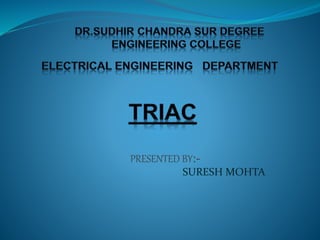
TRIAC
- 3. What is a TRIAC? The major drawback of an SCR is that it can conduct current in one direction only. Therefore, an SCR can only control d.c. power or forward biased half-cycles of a.c. in a load. However, in an a.c. system, it is often desirable and necessary to exercise control over both positive and negative half-cycles. For this purpose, a semiconductor device called TRIAC is used. TRIAC, from triode for alternating current, is a generic trademark for a three terminal electronic component that conducts current in either direction when triggered. Its formal name is bidirectional triode thyristor or bilateral triode thyristor . A thyristor is analogous to a relay in that a small voltage and current can control a much larger voltage and current. The illustration on the right shows the circuit symbol for a TRIAC where A1 is Anode 1, A2 is Anode 2, and G is Gate. Anode 1 and Anode 2 are normally termed Main Terminal 1 (MT1) and Main Terminal 2 (MT2) respectively. TRIACs' bidirectionality makes them convenient switches for alternating-current (AC). In addition, applying a trigger at a controlled phase angle of the AC in the main circuit allows control of the average current flowing into a load (phase control). This is commonly used for controlling the speed of induction motors, dimming lamps, and controlling electric heaters.
- 4. Difference between SCR & Thyristor:- SCR 1.SCR is a unidirectional device. 2.the gate current can be only positive. 3.SCR can operate in only one quadrant of V-I characteristics. TRIAC 1.It is a bi-directional device. 2.The gate current can be positive or negative. 3.can operate in two quadrants of V-I characteristics.
- 6. Triac Construction:- A triac is a three-terminal, five layer semiconductor device whose forward and reverse characteristics are identical to the forward characteristics of the SCR. The three terminals are designated as main terminal MT1, main terminal MT2 and gate G. Fig.2 (i) shows the basic structure of a TRIAC . A triac is equivalent to two separate SCRs connected in inverse parallel i.e. anode of each connected to the cathode of the other, with gates commoned as shown in fig.2 (ii). Therefore, a triac acts like a bidirectional switch i.e. it can conduct current in either direction. Fig.2 (iii) shows the schematic symbol of a triac. The symbol consists of two parallel diodes connected in opposite directions with a single gate lead. The gate provides control over conduction in either direction.
- 7. SCR Equivalent Circuit of Triac:- A TRIAC is equivalent to two separate SCRs connected in inverse parallel i.e. anode of each connected to the cathode of the other with gates common. Fig. shows the basic equivalent structure of a TRIAC.
- 8. V-I Characteristics of TRIAC
- 9. Operation of Triac:- The TRIAC can be turned on by applying the gate voltage higher than break over voltage. However, without making the voltage high, it can be turned on by applying the gate pulse of 35 micro seconds to turn it on. When the voltage applied is less than the break over voltage, we use gate triggering method to turn it on. There are four different modes of operations, they are- When MT2 and Gate being Positive with Respect to MT1 When this happens, current flows through the path P1-N1-P2-N2. Here, P1-N1 and P2-N2 are forward biased but N1-P2 is reverse biased. The TRIAC is said to be operated in positively biased region. Positive gate with respect to MT1 forward biases P2- N2 and breakdown occurs.
- 10. When MT2 is Positive but Gate is Negative with Respect to MT1 The current flows through the path P1-N1-P2- N2. But P2-N3 is forward biased and current carriers injected into P2 on the triac.
- 11. When MT2 and Gate are Negative with Respect to MT1 Current flows through the path P2-N1-P1-N4. Two junctions P2-N1 and P1- N4 are forward biased but the junction N1-P1 is reverse biased. The triac is said to be in the negatively biased region.
- 12. When MT2 is Negative but Gate is Positive with Respect to MT1 P2-N2 is forward biased at that condition. Current carriers are injected so the triac turns on. This mode of operation has a disadvantage that it should not be used for high (di/dt) circuits. Sensitivity of triggering in mode 2 and 3 is high and if marginal triggering capability is required, negative gate pulses should be used. Triggering in mode 1 is more sensitive than mode 2 and mode 3.
- 13. Advantages of Triac:- It can be triggered with positive or negative polarity of gate pulses. It requires only a single heat sink of slightly larger size, whereas for SCR, two heat sinks should be required of smaller size. It requires single fuse for protection. A safe breakdown in either direction is possible but for SCR protection should be given with parallel diode. Disadvantages of Triac:- They are not much reliable compared to SCR. It has (dv/dt) rating lower than SCR. Lower ratings are available compared to SCR. We need to be careful about the triggering circuit as it can be triggered in either direction. Uses of Triac:- They are used in control circuits. It is used in High power lamp switching. It is used in AC power control.
- 14. thank you